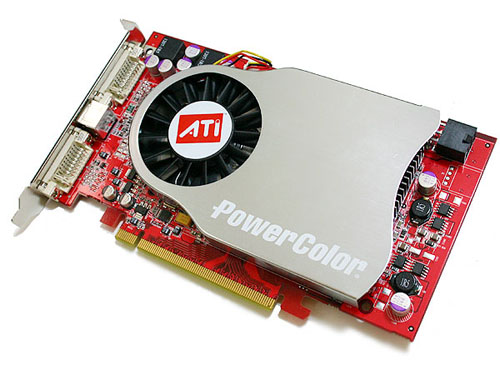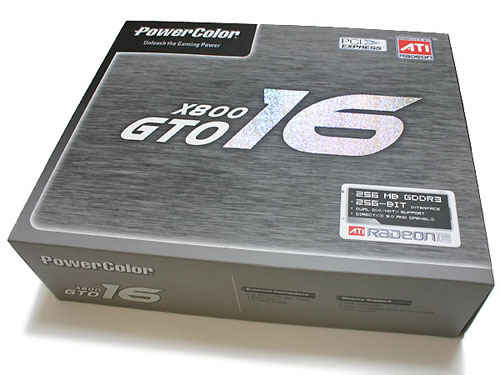ATI Radeon X800 GTO Mini Roundup: Sapphire, Connect3D, and PowerColor
by Josh Venning on December 26, 2005 12:05 AM EST- Posted in
- GPUs
PowerColor Radeon X800 GTO 16
Or last card, The PowerColor Radeon X800 GTO 16, is a bit different than the other three. As the name denotes, this card actually comes with the pixel pipelines unlocked to 16 as opposed to the standard 12 of the GTO. This will obviously give the card a little more power, and we will be able to see the kinds of performance gains that can be had by having these 4 extra pipelines open on the GTO.
This card looks similar to the GTO2 and the Connect3D GTO, yet interestingly, there are quite a lot of small variations between all of these GTOs that we had to review. The Sapphire X800 GTO Ultimate is definitely the odd one out in terms of looks, but that's to be expected, given the fanless heat sink. With the other three, not only are there different designs on the HSFs, but none of the heat sinks are exactly alike in shape as you would see on a different line of cards. This is logically a product of the “recycled” nature of these cards, but as we have said many times in the past, it's not the looks that are important; it is what’s on the inside that counts.
As you can see, the PowerColor X800 GTO 16 has a more subtle heat sink design, which is simply shiny silver and the PowerColor logo along the bottom. The box is also silver with the name of the card in the center and a big, sparkly “16” in reference to its extra pipelines. There is a game called Pacific Fighters included in the software bundle, which we haven't played, but that's the only thing besides the standard hardware that is included with the card.
It's important to note that this is the only X800 GTO in this review that comes factory overclocked in the sense that it has 4 extra pixel pipelines compared to the others, but the engine and memory clock speeds of all of these cards are the same (400MHz/490Mhz). The only other big difference between the PowerColor GTO 16 and the other three is that it has two DVI ports instead of one. Now let’s take a look at how these cards perform.
Or last card, The PowerColor Radeon X800 GTO 16, is a bit different than the other three. As the name denotes, this card actually comes with the pixel pipelines unlocked to 16 as opposed to the standard 12 of the GTO. This will obviously give the card a little more power, and we will be able to see the kinds of performance gains that can be had by having these 4 extra pipelines open on the GTO.
This card looks similar to the GTO2 and the Connect3D GTO, yet interestingly, there are quite a lot of small variations between all of these GTOs that we had to review. The Sapphire X800 GTO Ultimate is definitely the odd one out in terms of looks, but that's to be expected, given the fanless heat sink. With the other three, not only are there different designs on the HSFs, but none of the heat sinks are exactly alike in shape as you would see on a different line of cards. This is logically a product of the “recycled” nature of these cards, but as we have said many times in the past, it's not the looks that are important; it is what’s on the inside that counts.
As you can see, the PowerColor X800 GTO 16 has a more subtle heat sink design, which is simply shiny silver and the PowerColor logo along the bottom. The box is also silver with the name of the card in the center and a big, sparkly “16” in reference to its extra pipelines. There is a game called Pacific Fighters included in the software bundle, which we haven't played, but that's the only thing besides the standard hardware that is included with the card.
It's important to note that this is the only X800 GTO in this review that comes factory overclocked in the sense that it has 4 extra pixel pipelines compared to the others, but the engine and memory clock speeds of all of these cards are the same (400MHz/490Mhz). The only other big difference between the PowerColor GTO 16 and the other three is that it has two DVI ports instead of one. Now let’s take a look at how these cards perform.












27 Comments
View All Comments
Le Québécois - Monday, December 26, 2005 - link
Is it just me or the PowerColor GTO 16 has the exact same spec as the standart ATI Radeon X800XL?AtaStrumf - Monday, December 26, 2005 - link
Almost. X800XL runs at 400/500 vs. 400/490 of the GTO 16. They also both use the same .11 mikron R430 chip.mamisano - Monday, December 26, 2005 - link
Wow, you guys are getting really soft lately. The GTO2's main claim to fame is the ability to unlock the 4 extra pipelines and the tremendous overclocking headroom available. At least give it a try, it can always be flashed back if you experience problems.Second, did you actually remove any of the HS units to determine the actual core installed on each card? That and a list of brand/speed of memory used on each one would have been very beneficial to the overall review.
Seems to be another in a line of reviews with decreasing quality.
AtaStrumf - Monday, December 26, 2005 - link
I absolutely agree! Very low quality review and VERY, VERY late!!!Zoomer - Monday, December 26, 2005 - link
I research all of these cards before settling with the c3d gto - and I would have gotten the gto2 if it was avaliable.Sapphire GTO2
R480
Samsung 1.6ns
C3D GTO
R423
Samsung 2.0ns
PowerColor
R430
Samsung 2.0ns
An article at anandtech commented on why the Powercolor card (the R430) can't hit high clocks - although it uses a smaller process, the 130nm uses a low k process. The 110nm process does NOT. The article goes on to say that this shrink was to cut costs, at the expense of clock speed.
However, it is interesting to note that the die shrink didn't do anything to reduce power draw. An investigation into the voltages the R430 is running at is in order. :)
One more thing to note - the c3d has VIVO, with a rage theatre chip soldered (as usual) on the board.
I can't remember the ones for ultimtate, but the fireblade should also be using 1.6ns rams.
tuteja1986 - Monday, December 26, 2005 - link
I wonder why anandtech never did it earlier ;(coldpower27 - Monday, December 26, 2005 - link
At least the different manufacturer made it interesting, and customized the boards a little bit to differentiate from one another and not stick to the reference design.The 6800 GS is quite the competitor for the X800 GTO, and from my persepctive is a better buy if you want something straight out of the box save for the Powercolor X800 GTO 16. Though there is also the XFX Edition clocked at 485/1100 to worry about.